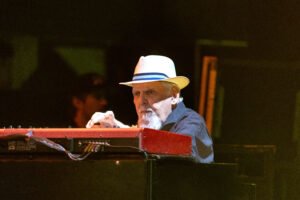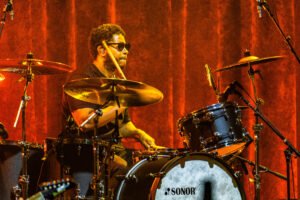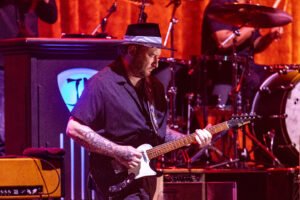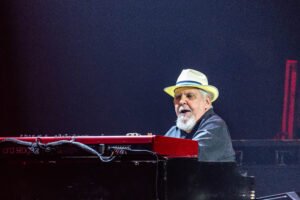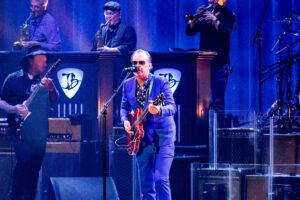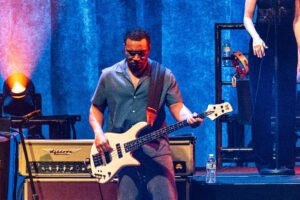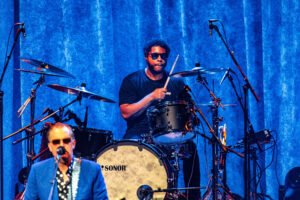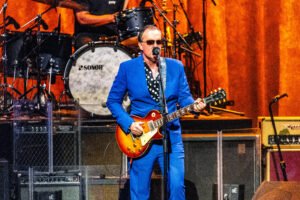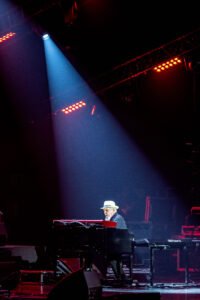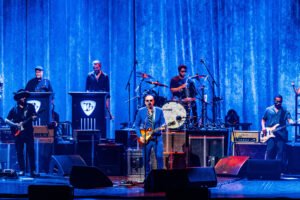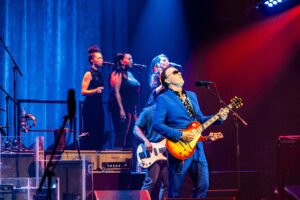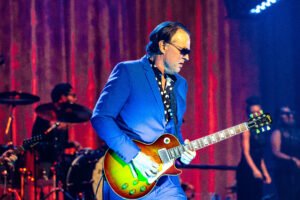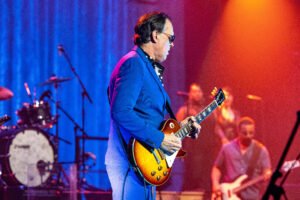Joe Bonamassa Fills The Hershey Theater With The Rich History Of The Blues

Joe Bonamassa is a renowned American blues-rock guitarist, singer, and songwriter who has built a prolific career with his exceptional guitar skills and soulful voice. Starting his journey at a remarkably young age, Bonamassa opened for blues legend B.B. King when he was just 12 years old, setting the stage for a career that would see him become one of the most respected names in contemporary blues. Over the years, Bonamassa has released numerous albums, both studio and live, that have topped the blues charts, earning him a dedicated following worldwide. His collaborations with other legendary musicians and his role in revitalizing the blues genre have further cemented his place as a leading figure in modern music.
Continuing to tour extensively, Joe Bonamassa brings his electrifying performances to stages across the globe, captivating audiences with his powerful guitar riffs and emotive vocals. And his show at The Hershey Theatre will no doubt be a testament to his enduring appeal and his commitment to delivering unforgettable live experiences. Fans at the Hershey Theatre can expect a dynamic setlist that showcases his mastery of the blues, highlighting both his classic hits and newer material, all delivered with the passion and precision that have become his trademark.
Joe would kick off the night’s festivities raucous “Hope You Realize It (Goodbye Again)” showcasing his ability to blend raw emotion with technical precision. The song’s melancholic lyrics and haunting melody are brought to life by Bonamassa’s soulful vocals and fluid guitar work. As he plays, his fingers dance effortlessly across the fretboard, delivering powerful yet nuanced solos that resonate with the audience. The song’s introspective nature is accentuated by the subtle interplay between Bonamassa and his band, particularly the keyboardist, who adds layers of depth with delicate, atmospheric chords. Drummer Lamar Carter’s gentle, steady rhythm underscores the song’s reflective mood, creating a cohesive sound that envelops the listeners in a bittersweet reverie.
In his cover of B.B. King’s “You Upset Me,” Bonamassa pays homage to the blues legend with a performance that is both respectful and inventive. He channels King’s spirit through his impeccable guitar tone, replicating the iconic vibrato and bends that defined King’s style, while also infusing his own energy into the performance. The band’s rhythm section, consisting of a tight-knit bass and drums duo, drives the song forward with a groove that is both relaxed and commanding, allowing Bonamassa to take center stage. Bassist Calvin Turner lays down a deep, rolling foundation that keeps the song anchored, while the drummer’s crisp, syncopated beats add a dynamic edge. The horns section, with its bright, punchy accents, adds a layer of excitement to the performance, paying tribute to the original while also elevating the energy of the live show.
“Twenty-Four Hour Blues” sees Bonamassa delving deep into the traditional blues territory, delivering a performance that is both intense and deeply moving. His guitar playing on this track is a masterclass in blues expression paired with fellow guitar slinger Josh Smith, with each note ringing out with a sense of urgency and despair that captures the essence of the blues. The band complements his playing perfectly, with the keyboardist adding a rich, soulful texture through Reese Wynans Hammond organ swells that echo the emotion in Bonamassa’s voice and guitar. The drummer, while maintaining a steady blues shuffle, injects subtle flourishes that enhance the song’s rhythmic complexity. The guitarist’s interplay with the horns section, which weaves in and out with tasteful fills, adds a layer of sophistication to the performance, making “Twenty-Four Hour Blues” a standout moment in the show. The synergy between Bonamassa and his band during this song is palpable, creating an electrifying atmosphere that leaves the audience spellbound.
“Self-Inflicted Wounds” is a powerful display of his ability to convey deep emotion through music. The song’s slow-burning blues structure allows Bonamassa to explore the full range of his guitar skills, delivering heart-wrenching solos that mirror the pain expressed in the lyrics. His vocals, filled with a sense of regret and introspection, resonate deeply with the audience. Behind him, keyboardist Reese Wynans creates a haunting atmosphere with his rich Hammond organ tones, which swirl around the melody and add a layer of complexity to the arrangement. Lamar Carter provides a restrained but steady beat, giving the song a steady pulse that keeps the emotion simmering just beneath the surface, while Turner grounds the performance with a deep, resonant bassline that complements Bonamassa’s guitar.
“The Last Matador of Bayonne” is a more cinematic piece, showcasing Bonamassa’s ability to blend blues with a broader musical palette. The song’s Spanish-flavored intro sets the stage for a dynamic performance that ebbs and flows with dramatic tension. Bonamassa’s guitar work is both delicate and fiery, as he alternates between intricate fingerpicking and explosive riffs that capture the spirit of the song’s narrative. Wynans’ keyboards add a sense of grandeur to the piece, layering in orchestral textures that give the performance a sweeping, almost epic feel. Carter and Turner and are in perfect sync, driving the song with a rhythm that is both propulsive and nuanced, allowing Bonamassa to explore the song’s emotional highs and lows with his guitar. The band’s tight interplay during this piece highlights their collective musicianship and ability to bring complex compositions to life.
“I Feel Like Breaking Up Somebody’s Home” was a masterclass in blues intensity. Bonamassa’s guitar work was electrifying, with every note dripping with emotion and precision. His vocals carried the weight of the song’s narrative, balancing raw power with soulful expressiveness. Behind him, the band was in perfect sync: Reese Wynans on keys provided a lush, textured backdrop, his organ swells and piano fills adding depth to the bluesy atmosphere. Lamar Carter and Calvin Turner provided a rock-solid rhythm section that drove the song forward with a steady yet dynamic pulse. But it was the backup singers, Jade MacRae and Dannielle DeAndrea, who added a transcendent layer to the performance. Their harmonies were rich and full, blending seamlessly with Bonamassa’s voice, yet standing out with their own soulful intensity. MacRae and DeAndrea’s vocal interplay was particularly mesmerizing, as they alternated between delicate, ethereal highs and powerful, gospel-infused crescendos, elevating the emotional impact of the song to new heights. Their contributions were not just supporting but integral, adding a vital element that made the performance truly unforgettable.
Next, Joe would serve up “Is It Safe to Go Home”, a poignant exploration of vulnerability and longing, highlighted by his soulful guitar work and expressive vocals. The song begins with a delicate guitar intro, where Bonamassa’s fingers glide effortlessly over the strings, creating a soft, melodic sound that immediately draws the audience in. His voice, filled with a sense of yearning, resonates with the lyrics, painting a picture of emotional uncertainty. Reese Wynans on keyboards enhances the song’s introspective mood with subtle, flowing chords that provide a lush backdrop to Bonamassa’s guitar. Anton Fig’s drumming is understated yet effective, offering a gentle rhythm that supports the song’s reflective tone without overpowering it. Michael Rhodes on bass adds a warm, comforting presence, his notes blending seamlessly with the rest of the band to create a cohesive, intimate sound.
“See See Baby,” a cover of Freddie King’s classic, shifts the energy of the performance into high gear with its upbeat, driving rhythm. Bonamassa’s guitar work is fiery and precise, channeling the spirit of Freddie King with sharp, staccato riffs and lightning-fast solos. His vocals are equally energetic, capturing the playful, almost teasing nature of the song. Reese Wynans shines on this track, his piano lines dancing around Bonamassa’s guitar, adding a lively, swinging element that perfectly complements the song’s bluesy groove. Guitarist Joh Smith was locked in with a tight, propulsive rhythm, with Carter’s drumming providing a steady, infectious beat, giving the song a solid foundation that keeps the energy high. The chemistry between the band members is palpable, and their performance of “See See Baby” is a joyful celebration of classic blues, executed with both reverence and flair.
Bonamassa’s rendition of “Hummingbird,” another homage to the blues greats, is a masterclass in emotional intensity and dynamic performance. The song begins with a tender, almost mournful guitar intro, where Bonamassa demonstrates his ability to convey deep emotion through subtlety and restraint. His vocals are filled with a sense of longing and devotion, matching the soulful lyrics of the song. Reese Wynans’ organ playing adds a rich, gospel-like quality to the performance, creating a powerful emotional undercurrent that elevates the song to new heights. The band delivers “Hummingbird” with a level of passion and precision that leaves the audience deeply moved, showcasing their collective ability to breathe new life into a timeless blues classic.
For the encore, Joe Bonamassa returned to the stage with a powerful rendition of Bobby Parker’s “It’s Hard But It’s Fair.” From the first note, Bonamassa captured the gritty essence of the original with his aggressive, razor-sharp guitar work. His solos were blistering, full of fiery bends and rapid runs that showcased his technical mastery and deep understanding of the blues. Vocally, Bonamassa delivered the lyrics with a raw intensity, his voice carrying the weight of the song’s hard-hitting message. Reese Wynans added depth with his Hammond organ, creating a swirling, soulful backdrop that enriched the overall sound. Together, the band breathed new life into the classic track, delivering a performance that was both respectful of its roots and infused with fresh energy.
Bonamassa closed the night with “Mountain Time,” a fan-favorite that perfectly encapsulates his blend of blues, rock, and Americana. The performance began with a gentle, melodic guitar intro that slowly built into an expansive, soaring soundscape. Bonamassa’s vocals were soulful and evocative, capturing the song’s themes of longing and the beauty of nature. As the song progressed, he launched into a series of powerful solos, each one more emotive than the last, showcasing his ability to convey deep emotion through his guitar. Reese Wynans added a lush, atmospheric quality with his keyboard work, layering in rich textures that complemented Bonamassa’s playing. For the final time, Lamar Carter’s drumming was dynamic, moving from subtle, understated rhythms during the verses to thunderous beats that drove the song’s climactic moments. While Calvin Turner’s bass provided a steady anchor, his deep, resonant notes giving the performance a grounded, earthy feel. As the final notes of “Mountain Time” rang out, the audience was left in awe of Bonamassa’s ability to craft a musical journey that was both intimate and epic, a fitting end to an unforgettable night.





